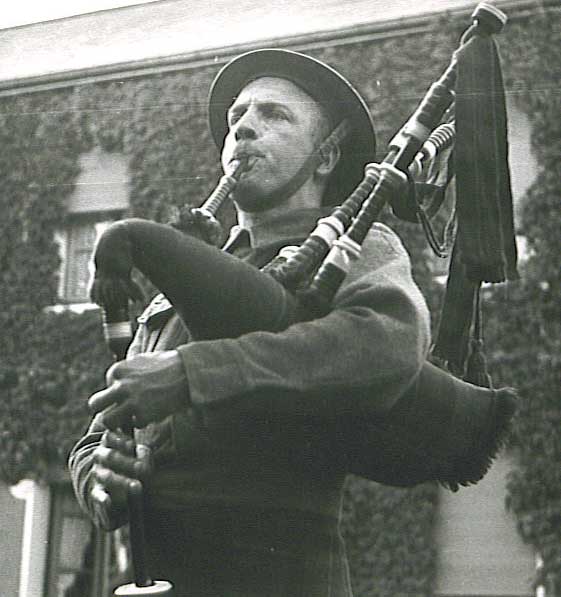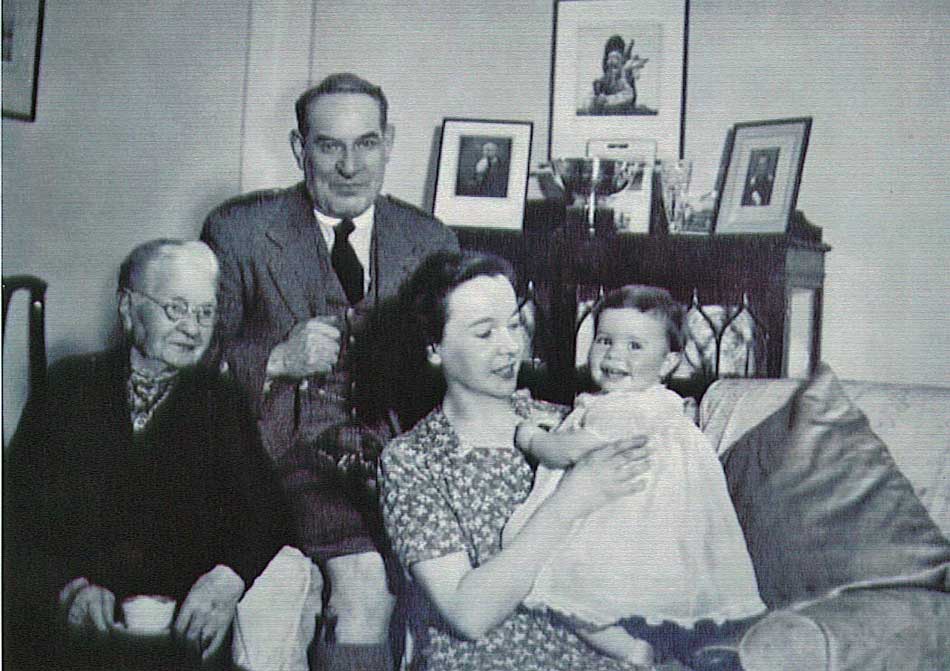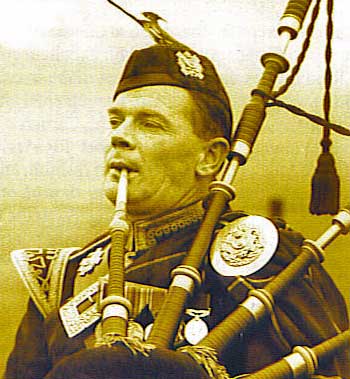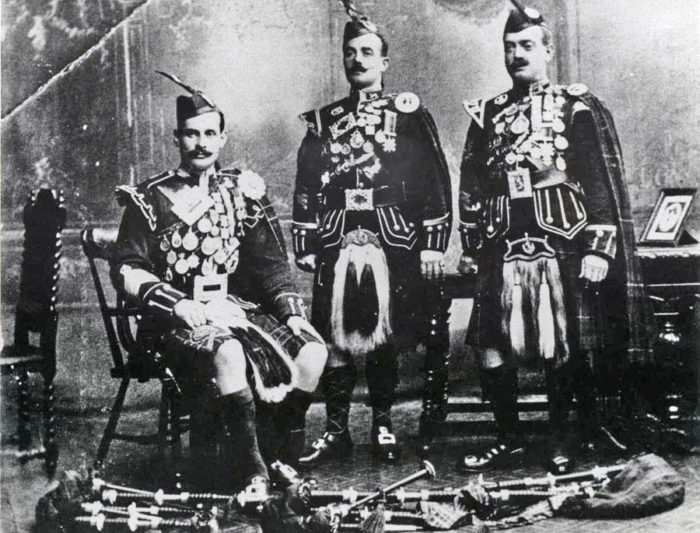Downloads below are free of charge
Here are some recordings taken from old 78 records. While they give us insight into how the great players played early in the last century, speculation abounds about the tempos, which are sometimes astonishingly quick. I once listened in on a conversation between Captain John MacLellan and John Wilson where they sadly shook there heads as they recalled how Willie Ross had “gone fast” in his latter years. However, on Ross’s recordings made as early as 1909 we hear competition marches played at a tempo reserved today for Grade 1 bands.
JOHN WILSON (1906-1979)

John Wilson was one of the leading pipers of the 1930s in Scotland. He emigrated to Canada in 1948, where he became the leading piping figure in Ontario for 30 years. His competitive and teaching record is all the more remarkable given that he lost most of the thumb and two fingers of his left hand as an 11-year-old when he found and detonated a small explosive device.
The year 1936 was his best and he was clearly the best competitive piper in Scotland that season. That year he made a series of recordings for Beltona. The recordings below were digitized from John’s own copies of the 78s, kindly provided by his widow, Margaret.
The playing is fast, but Margaret has told me that listening to those recordings many years later, John felt certain that he had not played that quickly. Yet recordings by other great pipers of the era display a similar quickness of tempo.
John Wilson, circa 1946, playing his hornpipes “St., Valery” and “Bobby Cuthbertson,” and an unknown hornpipe.
John Wilson, circa 1936, playing his jig “Roddie Campbell,” Ian C. Cameron’s “Islay’s Charms,” and Wilson’s “After the Games.”
John Wilson, circa 1936, playing two slow marches, “Starry Night in Shetland,” and “Leaving Lochboisdale.”
John Wilson, 1936, playing the march “Miss Elspeth Campbell,” the strathspey “Lady Louden,” and the reel, “Lochiel’s Away to France.”
PIPE MAJOR WILLIE ROSS (1878-1966)

An argument can be made for P/M Willie Ross being the most influential piper of the 20th century. His prominence on the world piping stage led to many studio recordings being made of his playing during his prime years from as early as 1909 until the 1930s.
Willie Ross, December, 1927 playing “Ghillie Calum” on a Parlophone 78 called “The Sword Dance.”
Willie Ross, February, 1927 playing the march “John MacDonald of Glencoe,” the strathspey “Captain Jack Murray” and the “Reel of Tulloch,” from a Parlophone 78. The pointing in the ending of the march is notable, as is the strathspey and reel selection — tunes/settings rarely heard today. Willie Ross was renown for the quality of his instrument, but the drones in this recording are strangely raucous. Apparently, in these days, because of the limitations of the directional horn microphones which would pick up the chanter well, but not the drones, players often had a second player blow a second set of drones in close proximity to the horn. This could lead to tuning issues as it has here.
Willie Ross, 1927, playing a scorching selection of reeds on a Parlophone 78 entitled “Eightsome Reel.” The tunes alternate back and forth between “De’il Among the Tailors,” and “Mrs. MacLeod of Raasay.”
Willie Ross, 1927, from another Parlophone 78 for dancing, called “Highland Schottische.” He plays the strathspeys, “The Keel Row,” “Stumpie,” and “Louden’s Bonny Woods and Braes.
PIPE MAJOR J. B. ROBERTSON (1905-1988)
 J. B. (James Blair) Robertson was born in 1905 in Dundee and joined the 1st Battalion of the Scots Guards at the age of 17. He was Pipe Major of the 2nd Battalion from 1932 until 1941. A contemporary of John Wilson’s, the two were good friends with strong competitive records. J.B. won the Former Winners’ M/S/R at Oban nine times, a record that still stands. He won the Former Winners’ M/S/R at both Oban and Inverness in the same year on three occasions: 1929, 1933 and 1937. He won the Gold Medal for piobaireachd at Oban in 1932 and at Inverness in 1933, but it is his legendary status as a Light Music player that continues to this day Those who heard him in his prime say he was the finest march player they ever heard. He died in 1988.
J. B. (James Blair) Robertson was born in 1905 in Dundee and joined the 1st Battalion of the Scots Guards at the age of 17. He was Pipe Major of the 2nd Battalion from 1932 until 1941. A contemporary of John Wilson’s, the two were good friends with strong competitive records. J.B. won the Former Winners’ M/S/R at Oban nine times, a record that still stands. He won the Former Winners’ M/S/R at both Oban and Inverness in the same year on three occasions: 1929, 1933 and 1937. He won the Gold Medal for piobaireachd at Oban in 1932 and at Inverness in 1933, but it is his legendary status as a Light Music player that continues to this day Those who heard him in his prime say he was the finest march player they ever heard. He died in 1988.
J. B. Robertson plays the ground of the piobaireachd “MacCrimmon Will Never Return” on this Parlophone 78 entitled “MacCrimmon’s Lament,” 1938
J. B. Robertson plays the march “Bonnie Ann,” the strathspey “Delvinside” and the reel “Miss Proud” in this 1938 recording provided courtesy of the Scottish Piping Society of London, of which J. B. was a long-time member.
Pipe Major J. B. Robertson leads the pipes and drums of the 2nd Battalion Scots Guards playing “Bonnie Dundee” from the flip side of the Parlophone recording above. This is a remarkable recording of a pipe band from the mid-1930s. It fades in gradually at the beginning and fades out at the end, presumably to give the effect of the band marching past the listener on parade. While the tuning and technical precision are far from modern standards, the rhythmic power provided by the low-pitched rope-tension drums and very simple drum scores is notable.
ROBERT REID (1895-1966)
 Robert Reid was John MacDougall Gillies’ greatest pupil. From the early 1920s until the start of the second world war he was a formidable prize-winning machine. He won the Gold Medal at Inverness in 1921 and at Oban the following year. He won six Claps at Inverness, and the Open Piobaireachd at Oban six times as well. He won the Former Winners’ M/S/R at Inverness four times. He set a record in the Open Piobaireachd at Cowal with 15 wins in 16 years between 1921 and 1938, missing out only in 1929. He was one of the great proponents of the so-called Cameron school of piobaireachd interpretation, and while his pupils enjoyed competitive success, they perhaps did not do justice to his powerful and stylized way of playing. Though there are supposedly 100 extent recordings of Robert Reid playing piobaireachd, few of them have been made public. Examples of his light-music playing are more readily available.
Robert Reid was John MacDougall Gillies’ greatest pupil. From the early 1920s until the start of the second world war he was a formidable prize-winning machine. He won the Gold Medal at Inverness in 1921 and at Oban the following year. He won six Claps at Inverness, and the Open Piobaireachd at Oban six times as well. He won the Former Winners’ M/S/R at Inverness four times. He set a record in the Open Piobaireachd at Cowal with 15 wins in 16 years between 1921 and 1938, missing out only in 1929. He was one of the great proponents of the so-called Cameron school of piobaireachd interpretation, and while his pupils enjoyed competitive success, they perhaps did not do justice to his powerful and stylized way of playing. Though there are supposedly 100 extent recordings of Robert Reid playing piobaireachd, few of them have been made public. Examples of his light-music playing are more readily available.
Robert Reid plays the G. S. McLennan 6/8 march “Captain John McLennan,” the strathspey “Tulloch Gorm,” and the reel “The Piper and the Dairy Maid” on an undated Beltona recording. Reid’s powerful technique is particularly evident in this searing strathspey. The noticeably sharp high G on the chanter is typical of virtually all solo piping recordings until well into the 1950s.
Robert Reid, 1936, from the flip side of the above Beltona 78, plays the slow air “My Home” and his signature and highly stylized version of the 2/4 march “The Highland Wedding.”
Robert Reid, 1936, plays “The Devil in the Kitchen” on this undated Beltona 78 recording entitled “Highland Fling.”
JOHN MACDONALD OF INVERNESS (1865-1953)

Universally identifed as “of Inverness,” John MacDonald’s long life spanned a tremendous golden age of modern piping, and his influence on it was profound. The testimony of his many pupils and of those who heard him in his prime lend credence to the belief that he may of been the greatest piobiareachd player of all time, exhibiting a rare combinaiton of technical prowess, expressive brilliance and a massive repertoire. His eight Clasps to the Inverness Gold Medal (five of these after he turned 60) stood as a record for decades. His teachers included Sandy and Colin Cameron and, most importantly, Malcolm (‘Calum Piobaire’) MacPherson, and he passed his gift to equally renowned pupils such as Bob Brown, Bob iicol and Donald MacLeod. He made a series of recordings between 1927 and 1928, when he was over 60, and two of them are provided here.
John MacDonald plays the Ground of the “Lament for Patrick Og MacCrimmon,” 1927.
John MacDonald plays the 2/4 marches “The Edinburgh Volunteers” and “Angus Campbell’s Farewell to Stirling” in 1928.
